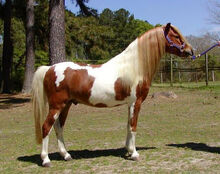
The first Shetland ponies for which there are written records were imported to the United States in 1885 by Eli Elliot. These ponies provided the foundation stock for the development of the American Shetland, and were crossed with ponies of other breeds, including the Hackney pony, Welsh pony, and Harness Show Pony. The breeding of the ponies was mainly centered in Indiana, Illinois and Iowa.
In 1888, the American Shetland Pony Club was formed and now has two studbooks: Division A and Division B. Division A registers ponies with 12.5% or less outcross (non-Shetland) blood, and Division B is open to any pony with 12.5% or more outcross blood. Foundation Certification is also available for ponies from 4 generations of Division A breeding. As of 2009 A and B designations are no longer on Registrations.
American Shetland Ponies are more refined than the traditional Shetland. They often have a long, thin, "hooky" neck, a more refined body, and longer legs. The breed tends to be long and narrow through the back, with broad and muscular hindquarters and high withers. The shoulder has good slope, allowing for extravagant action. These ponies are most often used for harness work and as children's ponies. They can be seen show jumping in classes for young riders, at horse shows in both Western and English riding classes, as well as many other competitive events, including gymkhana, novelty harness racing, and shown at halter, Costume.
The American Shetland Pony Club recognizes four types of Shetlands-Modern, Pleasure, Classic and Foundation. Modern Shetland are typically the tallest of the breed; they are shown with a high head set, ribbon braids in their manes, tail sets and have high stepping action. Pleasure ponies have similar breeding though their action is more subdued. Classic Shetlands are the most typical type and are known for their refinement and gentle nature while lacking most of the action of the Modern ponies. Finally, Foundation ponies do not have any Hackney influence for four generations and are all under 42" tall. Their looks are most reflective of their British ancestry.
However, the compact "classic" type of Shetland is still more prevalent in overall numbers in the USA, though such ponies are not always registered.
